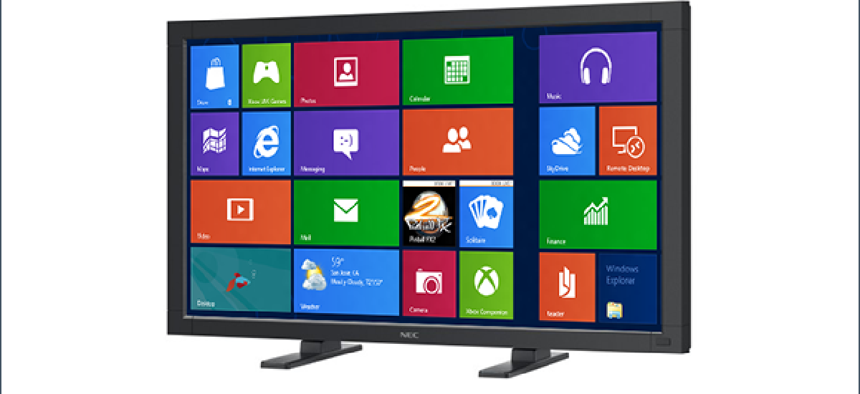A smart-phone touch screen in a 65-inch monitor

As touch-screen functionality moves to the desktop, even huge monitors are getting into the act. And NEC's 65-inch panel gets it mostly right.
Touch screens are pretty much required for all smart phones and tablets, but they have almost no installed base for desktops – so far. That will likely change in a big way as Microsoft Windows 8 begins to infiltrate the federal workspace. Even though Windows 8 works fine without a touch screen, it’s a lot easier to use with one.
As the next great input device, users will start demanding touch screens on their desktops or laptops. That will be especially true as agencies that use large screens for command centers, demonstrations or research find uses for one they can easily manage with a flick of the wrist.
Adding a touch-screen monitor to any desktop setup is surprisingly simple. Touch-screen monitors come with two sets of required cables. The first is the actual cable that will carry the video feed, be it HDMI, DisplayPort, DVI or even VGA. The second cable is USB, which enables the touchscreen to act as in input device in a way similar to a mouse or keyboard.
But making a good touch-screen monitor is not an easy task. Doing so requires getting around many of the problems associated with any display. Image quality, contrast, image continuity, color accuracy, balanced backlighting and ease of use are all important factors. But it also requires getting around the problems of a touch screen. Things like pointing accuracy, program response times and even fingerprint smudges can make or break a device.
The V651-TM has a whopping 65-inch panel size, which brings with it all the potential additional problems of a large monitor, but just about everything went right in our review. The V651-TM has a suggested retail price of $7,999, so it’s a big investment if it's not perfect for the job in mind.
As a touchscreen, the V651-TM is also above average. We drove the monitor using both a mid-performing system running Windows 7 and a bleeding-edge desktop running Windows 8, with one using the DVI input and one using the HDMI port. There was no difference in terms of response rate, though of course the Windows 8 system worked better because it is optimized for touch.
We’ve used better touchscreens, but not at this size. The biggest problem is that the glass panel is obviously at least semi-rugged, and seems to have a glare-resistant coating on it as well. However, this tends to make the screen a little less slick than a straight piece of glass. Doing long sweeping motions, as Windows 8 expects, we often found a finger getting “stuck” to the screen, long enough to lose the cursor for a moment. This was not a big problem, but it generally led users to push down a little harder, the natural human response. The screen can take the added pressure without a problem, but this leads to exaggerating another issue: fingerprints.
Fingerprint smudges are the bane of any touchscreen, and nobody has invented an effective barrier to keep human oil off a panel. The difference is that a tiny device can be cleaned using a small towel, or the corner of a shirt in an emergency. Cleaning this screen takes decidedly more effort. While the V651-TM is a perfect device to allow public interaction and a big display, expect to have someone assigned to anti-fingerprint duty on a regular basis.
The V651-TM would be a good monitor to have if that’s all it was. For a large panel to have no major image flaws is impressive, especially for such a big screen. Its touchscreen aspects are also well integrated, and the two taken together gives the display a high value. Users simply won’t find a more well-rounded display/input device combination at that size and price.
NEXT STORY: NEC's big screen is ready for its close-up





